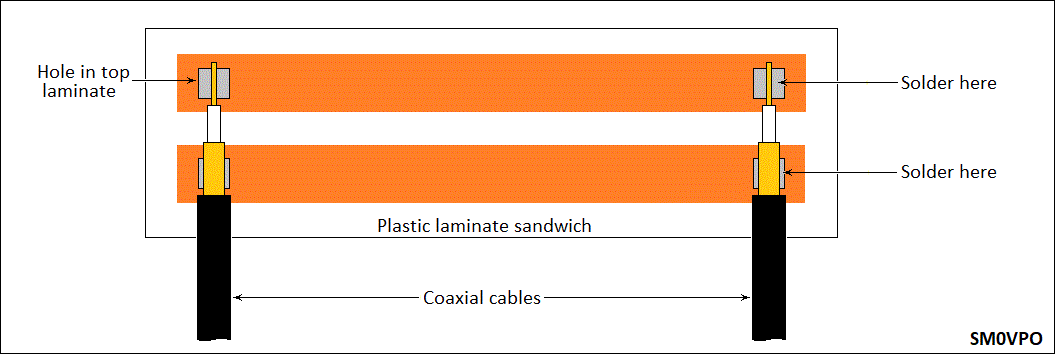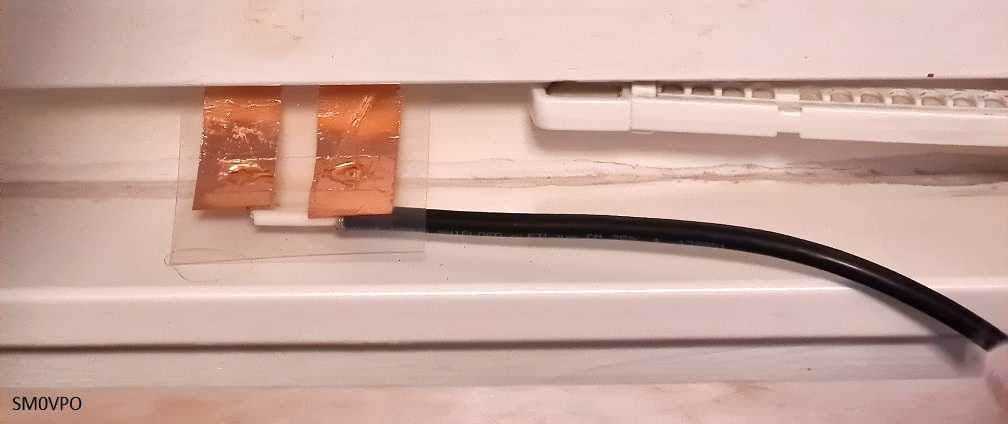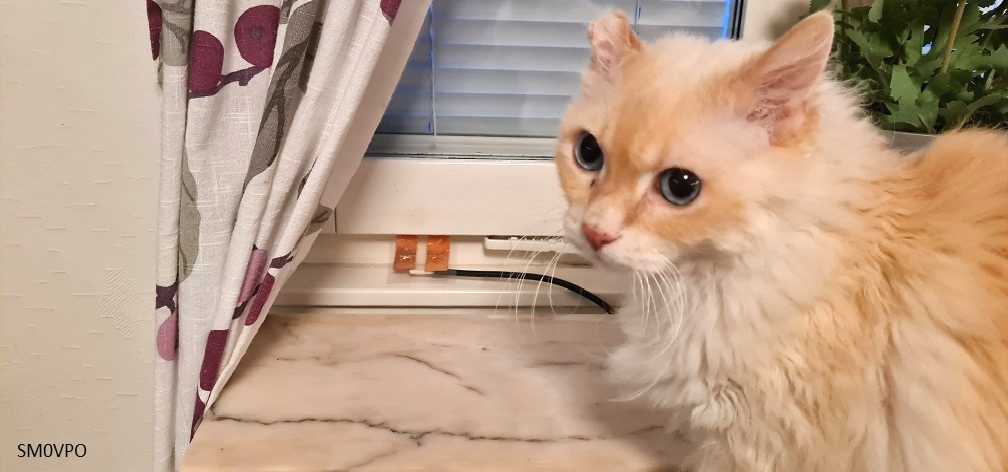

For the past two years I have been using my HF radio gear with a 60-metre feeder cable from the "shack" at the front of the house, to the antenna at the bottom of the back garden. I recently moved my shack to the back of the house and got the cable length down to just 13-metres (+/- about 2-metres). This alone saved me many dB in cable losses and improved my signals on the HF bands. Maximum frequency was 30-MHz (10 metre band), but now I occasionally use it for 145-MHz.
Although this gave me a better signal with fewer cable losses, it was still less than ideal in that I had a cable fed through an open window. I don't know about you, but I do not want to start drilling holes in a nice new window frame, even if it is wood. So, I put up with the draughty room for a couple of months. The onset of the Swedish winter, however, was not nice. Regular temperatures of -12°C (10°F) are normal, and I have frequently seen temperatures as low as -25°C (-13°F). Now it is time to do something, or freeze.
I initially looked for another route for the cable, but this was quickly dismissed. The only route was through the loft, and through a trapdoor to the roof. That would have meant more RG-58 RF cable, as well as trailing wires through the house. At 71 years of age, I am not particularly comfortable climbing on the roof. There had to be another way. I found another way - through the window 🙂.

What I really needed was a coaxial cable leading into the house, but with a thickness of only 0.25-millimetres or less, so that I can jam it between the window and the window frame. I am sure that there are many such cables available, but I only saw one for TV cable, after a Google search of the internet (US$50 - $12 for the cable and another $13 for the connector cables, plus postage and import duties, and a three week wait ☹). There is no way I am going to pay so much money to get two wires into the shack through the window, even if it is "the proper thing".
My idea was to feed a flat cable through the open window but have the cable so thin that I can close the window without damaging the cable, or the window. I did some tests with plastic sheets and found that 0.3-millimetres, or less, was practical. It must also be (sort of) weather-proof so that rain and snow will not affect the signals. It must be well insulated, and not easily damaged or torn. The signal losses must also be very low, and it would be nice if it could also stand RF powers exceeding 300 Watts. It would also be great if I can use the same technique for DC so that I can feed the output of a solar panel into the shack, to a battery, and power my 1000-Watt DC-AC inverter.

Construction was by far faster and easier than I had thought. My solution was to take some thin copper tape, and then encapsulate it in plastic laminate, to both insulate, and weather-proof the cable.
I cut a strip of copper tape lengthways to form two strips of copper, 2-cm X 22-cm. There may be a performance advantage to making the strips shorter, say, 10-cm. I then positioned the strips in an A4 sized plasic folder used for laminating documents. The two strips of copper are physically mounted 1-cm apart. The adhesive on the copper tape keeps them in place, but before laminating we need to make four holes to get access to the copper, to which we solder the external cables. I just used a felt-tipped marker pen to mark where I wanted the four holes to be, and then I cut the holes in the upper (top) plastic laminate sheet using a scalpel blade. The holes only need to be about 1 cm square.

Insert the sheet in the plastic laminator and then use scissors or guillotine to trim off excess plastic. There should be about 1-cm to 2-cm plastic around the copper, so the copper strips are totally enclosed. I then put the strip back in the laminator a couple of times to be 100% sure that the plastic was properly fused and gave a good, water-tight seal.
The next step is to connect the RF coaxial cable to the strip, and this can be soldered using a normal soldering iron, if the temperature is low: be sure not to have the iron too hot. The plastic laminate sheets will tolerate soldering without melting. I set my temperature-controlled iron to 240°C (460°F). Decide where you want the transition in the coaxial cable and cut the cable. Strip the two ends of the cable so that the centre and braid soldering points are 3-cm apart. Quickly tin the copper foil and the cable ends before making the solder connections.

Note that the cables must both be laid on the strip from the same direction. Be sure you have coaxial cable braid connected to braid, and centre connected to centre. In this way any rain or snow will lay on the un-soldered side of the strip, and not on the connection side. Be sure you have coaxial cable braid connected to braid, and centre connected to centre. If you need to bend cables to route them, be sure that the bend does not apply any streas to the soldered joint.
When this is done you can put a bit of double-sided adhesive tape on the back of the transition strip to help you position this on the window frame. It will keep it in place while you close the window. On the inside of the window, I also formed the cable with a 180° bend, so that on the outside of the window the RF cables lays straight, but in the inside, the bend allows the cable to continue in the same direction. It is most important that there is no stress at the solder points, otherwise the copper can be ripped off the transition cable.
I also sprayed my soldered cable connections generously with a water repellent spray, the same stuff that is used to waterproof shoes and coats. I wonder if you can use the stuff to waterproof babies nappies (diapers)? Just be careful when using this spray. It is really uncomfortable if you breath it or get it on your body. It can also dangerous if it gets into your eyes. I used a Covid-19 mask and carpenter's goggles when I sprayed mine. If you have already thrown away your Covid face mask, then do not worry. Use the left-hand ½ of a lady's brassiere (do not use the other ½ or you will look like a "right-tit").
This technique worked very well with the RG-58 prototype, but in the final version I used LEONI L semi-flexible (braid/aluminium screened) cable because it is perfect for my HF system. Do NOT use "Superflexible" or any other "ribbed" or "Corrugated" cable, because it is stiff, and it will apply too much stress on the transition solder points.

I was 1/2 expecting all manner of problems, especially as the window frame has an aluminium (aluminum) strip at the bottom. I was anticipating arcing, radiation, heating, and other nasty things. In reality, this was only an experiment for receive only, but the end results were far better than I thought they could be. I didn't do any extensive tests. The only tests I did were:
V.S.W.R. - At 28-MHz and 100-Watts I saw absolutely no difference with a direct cable and my transition cable
Signal loss - At 14-MHz and 100-Watts, I measured +47.6-dBm at the antenna direct, +47.5-dBm with the transition
Signal leakage - At 28-MHz and 100-Watts, no elevated RF (500-mm), other than RF from the antenna 12-metres away
Signal/Noise ratio - At 12,095-kHz (BBC World Service) the S/N ratio showed no difference (about 22-dB)
Observation - At 28-MHz and 100-Watts for 5-minutes there was no sparking, heating, smoke or any other nasty signs

The only disadvantage I can find with this method of leading an RF cable into the shack is that closing the window keeps everything stable, so opening the window is not a good idea. My window frame has two windows, so I can always open the other window if I need some ventilation. I also supported the coaxial cables on the inside and outside so that there is no mechanical stress applied to the transition strip.

This solution looks reasonable. The outside cable is supported on the window ledge, and the inside cable is positioned under the window shelf. It all looks quite acceptable and without wires dangling all over the place. If you should rip the copper pads off where they are soldered to the coaxial cable, then it is better to simply laminate a new cable transition and fit that in the window. It takes about 15-minutes to make a new one.

The cost of this project is about US$1.50, or about £1.00, and that cost is really the plastic laminate sheet. The "Copper Shielding Tape" I did not consider because a 10-metre roll is only about US$12 (GB£10, SEK 99kr inklusiv frakt), and you only need about 2% of that for the copper conductors.
In case you are unaware, copper tape is wonderful stuff. In the garden it can be used as a barrier for snails; they do not like the stuff. Copper also kills moss. If you suspend a bare copper wire along the roof of your house from two chimneys, then you will have a 7MHz antenna, and no moss on the roof or in the gutters. Copper paint was used on boat hulls to prevent barnacles, but here in Sweden it is now outlawed.

1 - Although this project runs under windows, it is NOT approved by Microsoft 😉
2 - The above solution is perfect for HF communications, but I have not done any real tests at VHF or UHF. I did, however, connect my 145-MHz 5-Watt Baufeng handheld and the V.S.W.R. was very low, about 1.1:1. This I can live with. But you know that it should not really be used for VHF.
3 - This solution can possibly be dangerous if you are using it to feed DC into your house from a solar panel. A 24-Volt, 100-Watt solar panel (4-Amperes maximum) can be short-circuited without a problem. In fact, this is how they test the current specification of a solar panel. If you have a lead-acid battery on the inside, then there is no current limiting. In the event of a short circuit this transition could possibly burn or cause a fire. If you use a solar regulator inside the house and there is no problem, or alternatively use a 3-Ampere fuse. Wire fuses have a 50% "safety margin" so it will take 4.5-Amperes before a 3-Ampere fuse blows.

I hope that this project has given you some "food for thought". You can always e-mail me at harry.lythall@[my domain].com. You can even use oeieio@hotmail.com or hotmail@sm0vpo.com as they are both valid e-mail accounts for me 😉 although I would prefer that you visit my messageboard if you have any questions about this, or any other project. I always look forward to receiving feedback, positive or negative 🙂

Very best regards from Harry - SM0VPO
Return to INFO page